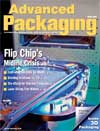Table of Contents
Solid State Technology
Year 2008
Issue 4
 | DEPARTMENTS
Editorial Board
UBM: Creating the Critical Interface
A variety of bumping technologies are in use today. Electroplating is used for fine-pitch (<250 μm) solder bumping, while robotic ball placement is used for larger pitch, lower (<100) I/O applications.
New Products
New Product Showcase
In The News
K&S Celebrates Next Gen Wire Bonders at SEMICON China
SHANGHAI — Fort Washington, PA-based Kulicke & Soffa Industries, Inc. launched two next-generation wire bonders just after SEMICON China opened for public viewing.
Editorial
From the Road
I love to sit in airports and imagine what people are like outside of travel. For instance, a fellow just walked by with fur-lined ear flaps on his camo hat and flip flops on his feet.
Advanced Packaging Road
To Infinity and Beyond
When it comes to semiconductor and MEMS devices, it is well-known that the industry is experiencing certain limitations – whether they are related to functionality, reliability or cost.
|
FEATURES
The Back End Process
Using Lasers to Dice Thin Silicon Wafers
Mechanical saw dicing is the conventional technology used for dicing thick silicon wafers.
Inside 3d Packaging
Enabling Next-generation Stacked-die Applications
Die-attach technologies improve throughput
Inside 3d Packaging
Bonding Solutions for 3D Integration
Throughout the past several years, various bonding methods for use in 3D integration have been undergoing evaluation.
Drie For Mems Devices.ht
DRIE for MEMS devices
A Cost-effective Solution
As high-volume MEMS production applications become a reality, device manufacturers are requiring low cost-of-ownership (COO) through high-yield at the wafer level and high overall equipment uptime. Several industrialized proprietary solutions have been developed to reach best performances.
Cover Story
Flip Chip’s Midlife Crisis
The negatives of lead-free solders have triggered a growing renaissance in tried-and-true flip chip technologies, as improved equipment and new applications boost twentieth-century approaches.
|